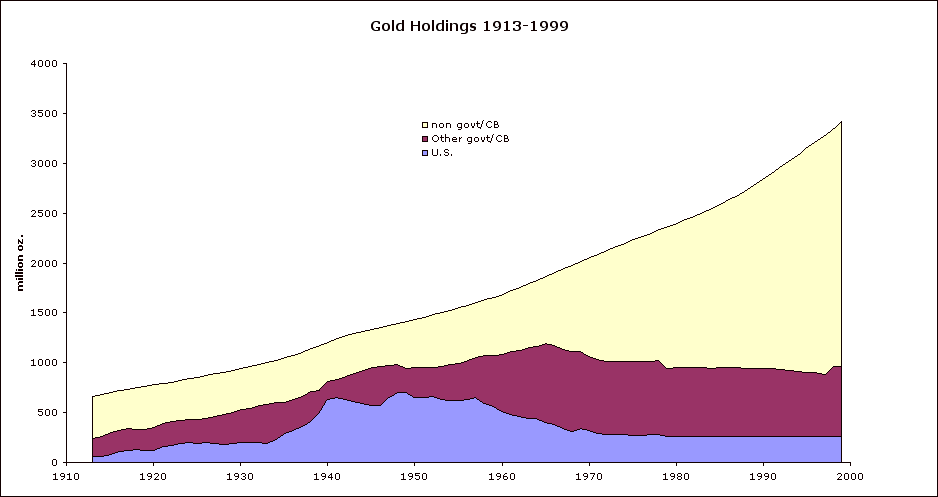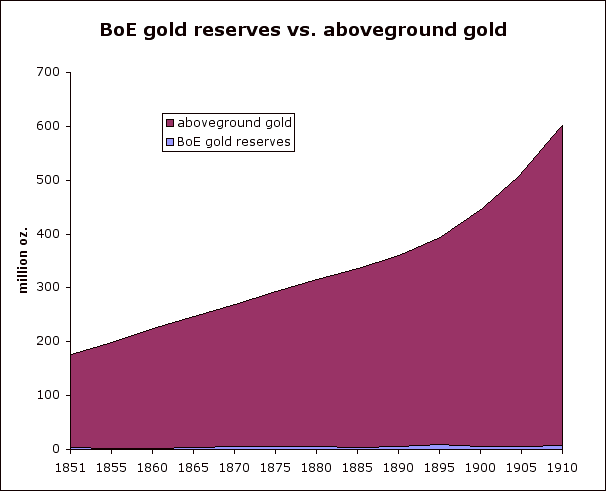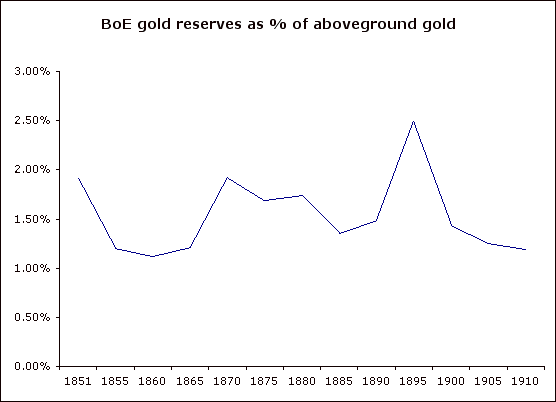A Gold Standard is a Value Peg
February 28, 2010
I’ve been reading Ron Paul’s new book End the Fed. Ron Paul is a national treasure. The book has lots of wonderful material, such as this passage from Aristophanes’ play The Frogs:
This city treats her soundest men today;
By a coincidence more sad than funny,
It’s very like the way we treat our money.
The noble silver drachma that of old we were
So proud of, and the recent gold coins that
Rang true, clean-stamped and worth their weight
Throughout the world, have ceased to circulate.
Instead, the purses of Athenian shoppers
Are full of shoddy silver-plated coppers
Just so, when men are needed by the nation,
The best have been withdrawn from circulation.
“Even in 400 B.C., as Aristophanes explains, and in ancient Egypt as described in the Old Testament, dishonesty in maintaining sound money coincided with the absence of moral leaders and excesses in foreign military aggression,” Paul writes.
All well and good. However, today’s gold standard advocates have some major shortcomings to correct. I used to think this was something like a personal weakness — that people just didn’t quite absorb the underlying theory behind hard money principles. Today, I think that, in fact, this has been a point of confusion for many decades. Ludwig Von Mises was probably the most talented monetary theorist of the 20th century — and I think he chuffed it on this point. So, it is no surprise that his intellectual descendants are having trouble with this too.
April 30, 2006: Value and Quantity
If we look at any gold standard throughout history, we find that it is a system that pegs the value of money to gold. The easiest way to do this was just to make the coins out of gold. However, this is problematic on many levels, so over time, it meant pegging the value of some token — a silver token coin, a wooden tally stick, a paper banknote — to gold.
I think people in the 19th century, such as David Ricardo, understood this, but they didn’t really lay it out in a literal fashion. Maybe it seemed so obvious that they didn’t think about it much.
In the U.S., this meant a dollar worth 1/20.67th oz. of gold, or $20.67/oz., and $35/oz. after 1933. In Britain, it meant £3 17s 10.5p per oz. of gold.
November 6, 2009: A Brief History of the Dollar
The gold standard was never a rule that said: “The number of dollars in circulation will be fixed at $600 million” or something like that. It should be obvious that if you fix the supply of dollars, but demand fluctuates, the value of the dollars will go up and down. Thus, you can’t have a value peg, like a gold standard, and a fixed supply of money. It’s the adjustment of supply — i.e. a changing amount of dollar base money — that allows us to make an otherwise worthless paper chit have a market value equivalent to gold.
January 3, 2010: The GLD Standard
In fact, you might find that, if you had a policy of fixing the number of dollars in circulation at some level, the dollar would plummet in value. Remember, the dollar is an international currency. About 70% of all the dollars in circulation are being used outside the United States, as the international currency of the world. People choose to use the U.S. dollar in trade because the U.S. government has a history of being slightly less stupid, in monetary affairs, that other governments. However, if the U.S. government did something stupid, like fixing the quantity of dollars at an unchanging level — causing the value to vary unpredictably — then people might not want to use it as the international currency of the world anymore.
The notion that a gold standard involves fixing the supply of money at some unchanging level is so easy to disprove that I find it appalling that the notion persists to this day among gold standard advocates. Certainly the ones who are sophisticated enough to be quoting Aristophanes.
“In an ideal world, the Fed would be abolished forthwith and the money stock frozen in place.” p. 203.
Now, I don’t want to pick on Ron Paul. This stuff is everywhere, among today’s self-proclaimed “Austrians.” Paul’s book serves here as a good window on the conventional wisdom in that camp, circa 2010.
Let’s look at the 19th century. The Fed was established in 1913, so this is before the Fed. An excellent reference on 19th century monetary policy in the U.S. is Richard Timberlake’s Monetary Policy in the United States: and Intellectual and Institutional History. This goes all the way back to 1800, unlike Milton Friedman’s book which only goes to 1867.
I have some statistics which show that the total amount of circulating “dollars” in the U.S. in 1775 was $12 million. This was largely in the form of coins, mostly foreign-made coins like the Mexican silver peso and Brazilian “joe.” (These were also “thalers.”) The population in 1770 is estimated at 2,148,100. Yes, two million people. The dollar in those days was worth about $20.67/oz. (It was actually worth a little more. The $20.67/oz. figure dates from 1834. But, it is close enough that we can treat it as unchanging.)
I don’t have a handy estimate for the monetary base in 1800. It was probably $40m or so, just as a wild guess, considering that the population in 1800 was 5.2m and they were probably a little wealthier than people in 1775. Not a whole lot wealthier, though, because they had suffered a couple decades of war and hyperinflation during the 1776-1789 period.
In 1910, with the dollar still at the same value of $20.67/oz., and before the Fed was created, there was $1,719m of currency held by the public, and another $1,410m of currency held by banks (bank reserves, vault cash), for a total of $3,219m. Banks held a lot more reserves in those days, because the Federal Reserve didn’t exist yet. Nevertheless, the banks had deposits of an amount 8x greater than their cash reserves. The U.S. population in 1910 was 92 million.
In 1930, we have $6,980m of total base money, consisting of $3,752m of currency held by the public, and $3,228m of bank vault cash. The population was 123m. This is after the Fed, but the dollar was still worth the same as in 1800, $20.67/oz.
So, we go from $12 million in 1775 to $3,129m in 1910, an increase of 26,075%, or 260 times. That is quite an increase in the amount of dollars out there — all of which happened before the Fed, and within the framework of the gold standard. Considering the increase in population, growing financial system, and generally greater wealth of 1910, this increase is no big surprise. That’s the way it’s supposed to work. The increasing demand for money (from the growing economy) is met by the increasing supply of money, producing a stable currency.
By 1930, the monetary base doubled again. However, the value of the dollar was the same. Although much of this increase in the 1910-1930 period was “caused by the Fed,” as the Fed had taken over the role of currency issuance by then, the expansion in the monetary base would have been about the same if the Fed didn’t exist. The doubling of the monetary base was simply the increase in supply necessary to meet the increase in demand over that period, to maintain the $20.67/oz. gold peg.
When these gold standard advocates talk about “fixing the supply of money,” they haven’t the slightest clue what they are talking about.
How about the “100% gold backing” notion. This has never existed. OK, not quite never. There have been a few examples, with the final one apparently the Bank of Amsterdam in the 17th century. Neither the British or U.S. gold standard examples, of the 18th or 19th centuries, have even a whiff of this “100% backing” notion. I wish I had better statistics on the Bank of England’s banknotes/specie ratios. I have heard that in 1780, the ratio was about 10:1. Ten times more banknotes than gold! Which is as it should be. That’s how gold standard system have always worked.
What about the U.S.? We have some statistics from Timberlake:
In 1810, there were 102 chartered banks in the U.S. In those days, each bank issued its own banknotes. It was a big mess, of course. Thirty of those banks reported their banknotes outstanding, and their reserves of specie (gold bullion). In 1810, these thirty banks had $5.58m of banknotes in circulation, and $2.49 million of specie — a 45% coverage ratio. This coverage ratio varies through the years. In 1818, for example, 147 reporting banks said they had $18.07m of banknotes in circulation, and $5.47m of specie — a 30% coverage ratio. You see what I mean? The amount of gold is irrelevant. It goes up, down, whatever, according to the whims of bank managements. The important thing is that those worthless paper chits — banknotes — trade at their specified market value of $20.67/oz. of gold.
I do have some statistics on total gold bullion holdings as a percentage of total aboveground gold:

The top line is all the gold in the world, which grows slowly due to mining production. The yellow is all the gold not held by governments/central banks. The red is the gold held by non-U.S. governments/central banks, and the blue is the portion held by the U.S.
We see that around World War II, the U.S. government held an enormous amount of gold — about 50% of all the gold in the world, and maybe 75% of all the gold held by all governments.
This is probably the high point of ownership concentration in world history.
However, this was not enough to “back” all the dollars in circulation (base money):

Even all that gold was only enough to cover about 50% of the dollar monetary base of the time. And the rest of the world? Fuggeddaboudit! However, this period of the 1950s and 1960s was a gold standard era, even if an embattled one. This period, from 1914 to 1970, represents the time when the U.S. dollar was the premier gold-linked international currency in the world.

This is a similar chart for the Bank of England. The top line shows all the gold in the world. The blue portion is the gold held by the government/central bank of England.
During this period, the British Pound was the premier gold-linked international currency of the world. In 1900, the British pound had been linked to gold (with a couple lapses) for over two hundred years. Certainly, when people talk about the gold standard, they must be talking about the British pound in the 19th century, no?
You can barely see the blue portion here. The Bank of England had almost no gold. However, it managed the supply of paper banknotes so that they would maintain their value link to gold. It worked, of course.

Here is the same in percentage terms. The Bank of England had an average of about 1.50% of all the gold in the world. Like I said, if you know of a good source for the banknotes/specie ratio for the BoE 1700-1900, I would love to see it.
Walter Bagehot, in Lombard Street (1873), shows the Bank of England’s Issue Department with £33m of banknotes issued and £18m (about 4.6m oz.) of gold bullion.
Walter Bagehot, Lombard Street (1873)
Unfortunately, most of today’s gold standard advocates haven’t the slightest clue as to how to create a working gold standard system. Maybe they should figure it out.

